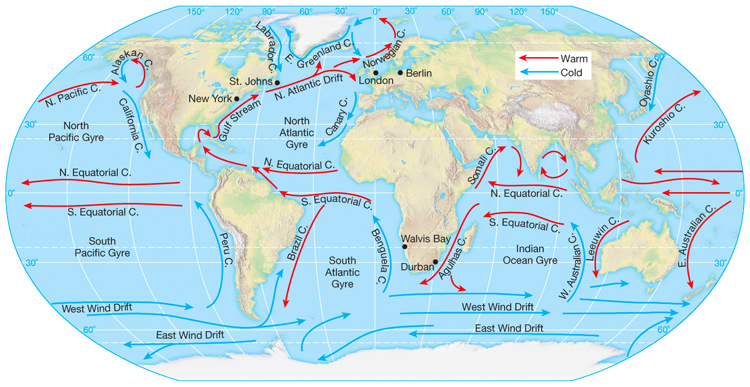What is the current sea surface temperature? Is it cold, cool, or warm for a swim, surf, or dive in the ocean?
The average seawater temperature worldwide varies throughout the decades, but it is generally around 63 °F (17 °C).
Various factors influence the five oceans' temperatures, including ocean currents, depth, and latitude.
Near the equator, the water is generally warmer, while at higher latitudes, the water is colder.
In addition, deeper water tends to be colder than shallower water.
Nevertheless, ocean currents play a significant role in determining seawater temperatures. They have a regulatory effect.
Warm ocean currents, such as the Gulf Stream in the North Atlantic, can bring warmer water to cooler regions, while cold ocean currents, such as the Labrador Current, can bring cooler water to warmer regions.
So, what is the ocean temperature near you?
Click on the following map and check the seawater surface temperature in any location worldwide.
The Role of Currents in World Seawater Temperature
But can massive movements of water change out-of-time temperatures locally? They surely can.
"In areas where there is a strong surface current flowing past the coast, the surface water is continually replenished by water from somewhere else, giving it little chance to warm up or cool down with the seasons," Tony Butt and Paul Russell explain the book "Surf Science."
"The water brought by the current may originate from somewhere where the temperature is completely different, giving the coastal waters a totally uncharacteristic temperature for their position."
For example, in Southern Africa, the huge Benguela current flows right next to the west coast, bringing freezing cold water from the Antarctic, even in summer.
Here, especially during strong upwelling events, the water can be colder in summer than in winter.
"The second reason for apparently illogical water temperature behavior is the phenomenon of coastal upwelling, which affects western sides of continents such as Southern Africa and South America," add the authors.
"Here, the trade winds, aided by the Coriolis force, continually blow the surface water away from the coast, allowing cold water from underneath to rise up to the surface."
"This, along with the surface current, ensures that the surface water is constantly replenished, making it even colder and more resistant to seasonal changes."
"In the coastal deserts of Namibia and western South Africa, it is not uncommon to find water temperatures of 51 °F (11 °C), with land temperatures soaring above 104 °F (40 °C) at the same time."
However, places well away from the reach of ocean currents, like Belgium, the Netherlands, and Germany, are like stagnant pools, where the temperature goes up and down fast and with the seasons.
The ocean temperature can also vary seasonally in both hemispheres, especially in temperate regions.
In the summer, they tend to be warmer, while in the winter, they tend to be colder.
The temperature of seawater is also affected by climate change.
As global temperatures rise, the sea temperature is also increasing, with significant impacts on marine ecosystems and the global climate system.

Average World Ocean Water Temperatures: Highs and Lows
As we've seen above, the regions with the lowest and highest average seawater temperatures vary due to several factors.
The region with the lowest average ocean temperatures is typically the Arctic Ocean, which is located at high latitudes and covered in ice for much of the year.
During the summer, when the ice melts, the sea's temperature remains relatively low due to the influx of cold freshwater from melting ice and the lack of direct sunlight in the region.
On the other hand, the regions with the highest average ocean temperatures are typically found in the tropical oceans, particularly in the western Pacific, where the warmest temperatures can exceed 86 °F (30 °C).
This is due to the high levels of solar radiation received in these regions and the influence of warm ocean currents such as the Kuroshio and the North Equatorial Current.
In tropical regions, such as the Caribbean, the average seawater temperature is around 79-82 °F (26-28 °C), while in more temperate regions, such as the Mediterranean, the average water temperature is around 64-72 °F (18-22 °C).
Other regions with high temperatures include the Red Sea and the Persian Gulf, which are both enclosed bodies of water with limited exchange with the open ocean, resulting in higher temperatures.
It's important to note that these temperatures can vary greatly depending on the time of year.
Slow Changes
There's another curious phenomenon regarding ocean temperature.
Have you noticed that if you live somewhere where the water temperature varies quite a bit throughout the year, the seasonal variations are totally out of phase with the seasons themselves?
In other words, the slow heating and cooling of the sea translate to maximum and minimum sea temperatures not occurring in mid-summer and midwinter but instead months afterward.
In early spring, for example, just when the weather is starting to warm up, the sea might still be cooling down.
And in autumn, just when the air is starting to become a little chilly, the water is at its warmest or may still be warming up.
But there's an explanation for this unusual behavioral pattern.
"The oceans require a massive energy input to allow their temperature to rise just a few degrees, which may take months," conclude Butt and Russell.
"Then, when the heat input is reduced, it takes months for the oceans to cool down again."

The Sea Surface Temperature (SST) Concept
The sea surface temperature (SST) is the temperature of the top layer of the ocean, which is in direct contact with the atmosphere.
This layer of water can vary in depth from 0.04 inches (one millimeter) to 70 feet (20 meters).
Sea surface temperature is an important parameter in understanding and predicting weather and climate patterns, as well as studying the health and behavior of marine ecosystems.
SST is influenced by multiple factors, including solar radiation, wind, ocean currents, and the exchange of heat between the ocean and the atmosphere.
Satellites are used to measure SST around the world by detecting the amount of infrared radiation emitted by the ocean's surface.
These measurements can be used to create maps of SST that can help scientists monitor changes in ocean temperatures over time, identify oceanic phenomena such as El Niño and La Niña, and aid in weather forecasting.
